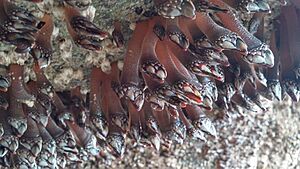Goose barnacle facts for kids
Quick facts for kids Pedunculata |
|
|---|---|
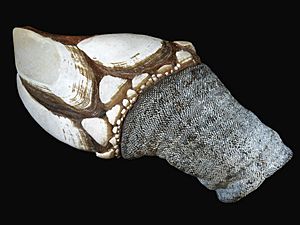 |
|
| Pollicipes pollicipes | |
| Scientific classification | |
| Kingdom: | |
| Phylum: | |
| Subphylum: | |
| Class: |
Hexanauplia
|
| Infraclass: | |
| Superorder: |
Thoracica
|
| Order: |
Pedunculata
Lamarck, 1818
|
Goose barnacles (also known as stalked barnacles or gooseneck barnacles) are fascinating sea animals. They are a type of crustacean, which means they are related to crabs and shrimp. These creatures have a special way of eating: they are filter-feeders. This means they catch tiny bits of food from the water. You can find goose barnacles attached to hard surfaces like rocks or floating objects (called flotsam) in the ocean, especially in the area where the tide goes in and out.
About Goose Barnacles
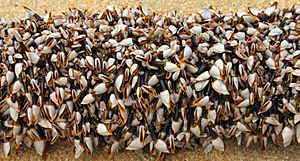
Some types of goose barnacles, like Lepas anatifera, live in the open ocean. They are often found attached to floating debris that washes up on coasts. Other kinds of goose barnacles, such as Pollicipes pollicipes, live in rocky areas where the ocean waves are strong. Unlike most other barnacles, these intertidal goose barnacles rely on the movement of the water to bring them food. They don't move their feeding parts as much. This is why you'll only find them on coasts with strong or moderate waves.
The Old Myth of Goose Barnacles
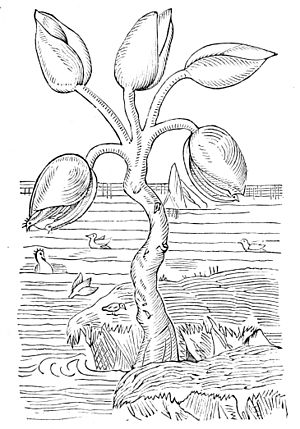
Long ago, people didn't know that birds migrate (travel to different places for seasons). Because barnacle geese were never seen nesting in Europe, people came up with a strange idea. They thought that these geese grew directly from goose barnacles! This idea was called "spontaneous generation".
The confusion happened because the barnacles and the geese had similar colors and shapes. Also, barnacles were often found on driftwood, which made people think they were attached to branches before falling into the water. An old writer named Gerald of Wales even wrote about this belief.
Because people thought barnacle geese were "neither flesh, nor born of flesh," some Christians believed it was okay to eat them on days when meat was not allowed. However, not everyone agreed. A ruler named Frederick II looked closely at barnacles and saw no signs of a bird inside them. Another person wrote about how surprised he was to be served goose on a meat-free day, showing that the idea was questioned.
Goose Barnacles as Food
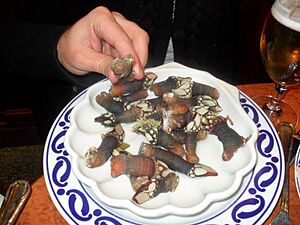
In countries like Portugal and Spain, a type of goose barnacle called Pollicipes pollicipes is a very popular and expensive food. It's known as percebes. These barnacles are gathered by hand from the northern coasts of Spain, especially in Galicia and Asturias. They are also found on the southwestern coast of Portugal. Some percebes are also brought in from other countries, like Morocco.
In Spain, percebes are usually boiled quickly in salty water and served hot. To eat them, you pinch the diamond-shaped foot between your thumb and finger. Then, you pull the soft inner part out of its hard, scaly shell. You remove the small claw, and then you can eat the rest of the tasty flesh. Long ago, the indigenous peoples of California also ate the stem of these barnacles after cooking them in hot ashes.
See also
 In Spanish: Percebes para niños
In Spanish: Percebes para niños


